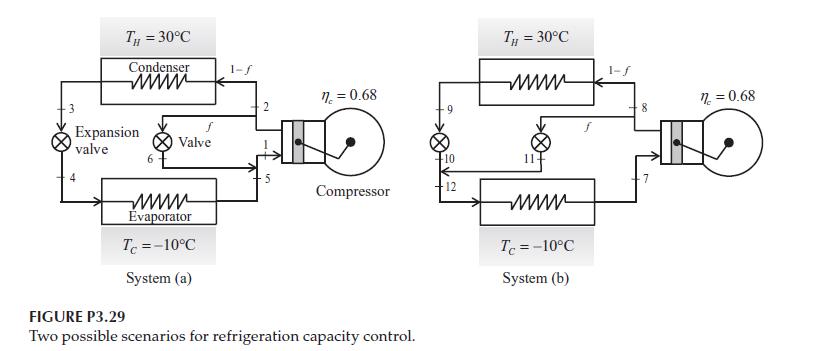Refrigeration equipment is often installed with more cooling capacity than is needed. The best way to operate
Question:
Refrigeration equipment is often installed with more cooling capacity than is needed. The best way to operate the equipment when the cooling load is lower than the capacity is to reduce the compressor speed with a variable speed motor.
However, variable speed motors and controllers can be quite expensive. In lieu of a variable speed motor, the capacity of the refrigeration cycle can be controlled using a refrigerant bypass line. Figure P3.29 shows two possible ways of accomplishing this. Both systems are based on a standard vapor compression refrigeration cycle.
System (a) recycles a fraction, f, of the compressor discharge back to the compressor suction line. System (b) directs a fraction, f, of the compressor discharge to the evaporator inlet.
Other than the bypass modification, both systems are identical in every other respect; the cold space is being maintained at −10°C while the condenser sink temperature is 30°C, the refrigerant is ammonia, and the compressor isentropic efficiency is 68%. The refrigerant leaving the evaporator is a saturated vapor at −15°C.
Leaving the condenser, the refrigerant is a saturated liquid at 40°C. The compressor is a single speed reciprocating compressor with a volumetric efficiency of 75%.
The volumetric displacement rate of the compressor is 20 L/s. The volumetric efficiency of a reciprocating compressor is defined as,
a. Determine the cooling capacity (tons), the cooling COP, HPT, and exergetic efficiency when the bypass is closed (i.e., determine these performance parameters for a standard vapor compression refrigeration cycle operating at the given conditions). The dead state can be taken as 1 atm, T0 = TH = 30°C.
b. Determine the value of f at which the cooling capacity is 80% of the full-load value found in part (a) for both systems. Calculate the quantities indicated in part (a) for each system under this part-load scenario.
c. Which capacity control system do you recommend and why?
Step by Step Answer:

Thermal Energy Systems Design And Analysis
ISBN: 9781138735897
2nd Edition
Authors: Steven G. Penoncello





